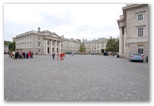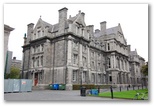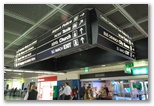Lisbeth and I went to Dublin earlier this month for four days. She was attending a class at the Microsoft Dublin campus, and I just tagged along for the fun of it. Neither one of us had been to Ireland before, and we were looking forward to, among other things, hearing Irish accents and drinking some Guinness.
For the weekend we stayed at Trinity College, which rents some of its dorm rooms out during the summer break. It’s a really nice campus in the heart of the city, so it’s a fantastic place to stay.
One thing that surprised me about Dublin is that all the public signs are both in English and in Gaelic. I thought Gaelic was pretty much dead, but apparently there is a movement to keep it alive. In fact, in Western Ireland, English town names have no legality in government documents or survey maps, and English has been banned from use on road signs.
A cab driver told us that Dublin has terrible traffic, and that the transit system is insufficient for the city’s needs. That seemed about right. They have a nice “light rail” system, but it doesn’t seem nearly as extensive as it should be. It’s called the LUAS (which apparently is Gaelic for “speed”), and it currently serves two unconnected lines in Dublin. But in its defense, Dublin is one of the fastest growing capitals in Europe, so it’s not surprising that people are having trouble getting around.
There’s another train system called DART. It’s been in service since 1984, but some of the cars look other than that. It’s noisier and rougher than the trains in Copenhagen, but it’s a perfectly fine way to get around.
There’s yet another form of transit available before one has to resort to cabs, and that’s the bus system. Maybe it’s even more so in London, but Dublin has a lot of busses, and most of them are double-deckers.
As in the UK, driving is reversed compared to the rest of the world. Steering wheels are on the right side of the cars, and the cars are on the left side of the road. I’ve been to the British Isles twice now, and both times I don’t really notice that the cab or bus I’m in are on the wrong side of the road.
What I noticed (other than the misplaced steering wheels) is that crossing a street is far more dangerous because I’m look in the wrong direction. Apparently this is enough of a problem in Dublin that they have “LOOK RIGHT” painted on the pavement on most crosswalks. I wonder how many tourists have died or been seriously injured, stepping out in front of a car or bus while looking the other way.
There are a lot of churches in Dublin, some of which are quite stunning. We tried to see the inside of the Christ Church cathedral (in the first picture below), but it was a Sunday and a service was in progress.
Probably the most famous and trendy part of Dublin is the Temple Bar area. It’s quite different from the rest of Dublin, primarily because it wasn’t popular in the 60s, when developers were replacing old buildings with new ones.
Another popular area is the Henry Street area. It’s much more modern, and is just a long pedestrian street with store after store. I took the first picture below just because…well, how long has it been since anyone has bought a “car phone”? The third picture below includes the Dublin Spire. There’s a better picture of the spire here.
I wouldn’t describe Dublin as a particularly charming city. It’s a mix of old and modern, which is a little unpleasant. But there are nice things about it. The people were quite friendly, but it’s hard to say whether the Irish were friendly, as Dublin is packed full of tourists, and so many of the employees are immigrants from Eastern Bloc countries. We did, of course, get to hear some Irish accents, but not nearly as much as we’d imagined. I included the third picture below because they have these little packets at every table in every pub and cafe.
There is also an unpleasant side to the city. We walked though several different parts of town, and there are definitely areas that are depressing and a bit rough. The first picture below was a part of town where every business seemed to be defunct. I’ve never seen so many drawn metal shutters, and it was that way for blocks.
The second picture is a common sight. Most cities get the trash out in alleyways — away from the street, but not in Dublin. Big bags of trash on the sidewalks is a common sight.
To the Northwest of town there’s Phoenix park, one of the biggest parks in Europe. It’s quite pretty, although the charm is somewhat diminished by the fact that there’s a lot of car traffic. We rented some bikes and rode across the park and back, which is a great way to see the park.
Back in town, I couldn’t get over how many Jack Daniels ads there were. They were EVERYWHERE. I was struck by two things: first, the idea of pushing a mediocre-at-best American whiskey in a country famous world-wide for fine whiskeys and scotches is pretty funny. Second, the posters all refer to Jack Daniels and “Mr. Jack”. Who is Mr. Jack? I only know a Mr. Daniels.
For the second two days we moved to a hotel that was selected by the travel agents contracted by Microsoft to arrange business travel. It was a place that neither one of us would have picked, and a big change from the dorm room we’d been in. The Four Seasons is quite a distance from the city center, in a suburb called Sandymount, and is fancy. Quite fancy.
It’s the kind of place where they take your bags from you at the door, and they’re in your room by the time you get off the elevator. And yet not so fancy that they don’t charge you 22 Euro ($31) a day for Internet access, or 10 Euro ($14) for about 20 pistachios from the “mini bar”. Seriously.
But the main thing that I noticed was that they’d come into the room, apparently several times a day, and do things intended, I’m sure, to be a service, but that made me feel quite uncomfortable. They’d put my razor and toothbrush on a little towel on the sink, and my dirty underwear and socks on a plastic bag on the floor where I’d left them. I felt like I was being scolded. “See? See the mess you made? You see it? Where should this go next time? Hmmm?”
I accidentally stumbled across the birthplace of William Butler Yeats. Very unremarkable, and basically just across the street from the Four Seasons.
And three last pictures: Lisbeth, from our room at Temple College, Dublin at night, and finally, Dublin from the hotel window at dawn.
And yes, the Guinness was tasty, and easier to get than an Irish accent.














































In China I saw Jack Daniels ads everywhere, and it was by far the most popular whiskey there. (Except for one place called “Johnny Walker’s Club.”) It’s really more a function of great marketing than being the best bourbon. Because, of course, Woodford Reserve is the best.
Interestingly, the Danish brand Carlsberg is the most popular imported beer in China.
Well, Carlsburg is tasty, even if it is a bit boring.
In Dublin, after an honest try, Lisbeth switched back to Carlsberg. I stuck with the Guinness, and really did enjoy it, but when I got back to Copenhagen, the Carlsberg tasted better than ever.
Impressive, Stan! I see (in the third-to-the-last photo) that the young woman looking at the sights does indeed have a face.
We spent about a week in Dublin in June. It has all those problems you spoke of and more. Part of the issue is that Dubliners have money for the first time, ever, and just don’t know what to do with it. As far as the shuttered buildings, there are a lot of areas waiting for redevelopment, but there’s also a lot of areas waiting for the weekend or night. Our hotel/pub was right next to Trinity on Pease Street and the pub on the opposite corner was shuttered – until Friday and Saturday night. If you do go back to Dublin, by the way, find The PorterHouse on Parliament Street. Guinness is good, but Wrasslers XXX is better. Also, try the west of the island if you want to see the Ireland Americans expect to see.
http://teevnus.blogspot.com/ – my view on Ireland
http://ropersabroad.blogspot.com/ – my fellow travelers (wife included)